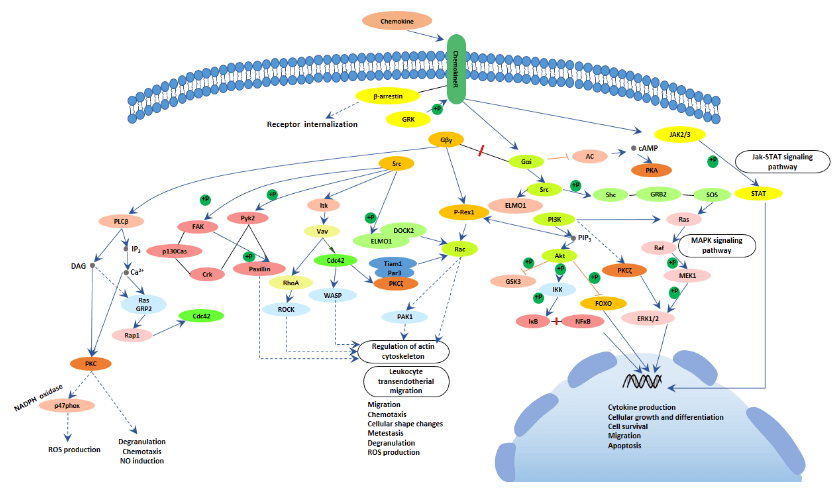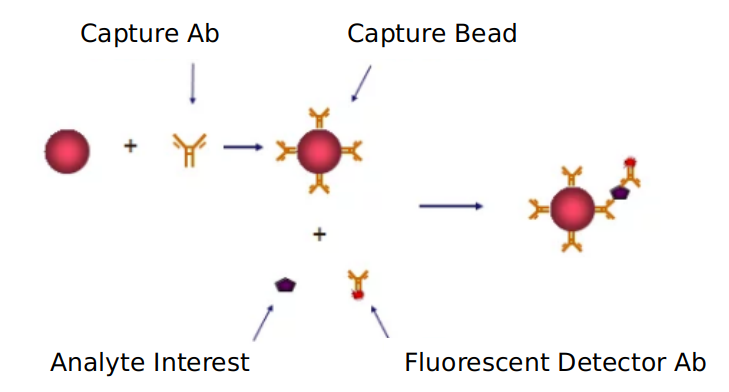Introduction to Chemokine signaling pathway
Based on Luminex technology platform, Creative Proteomics provides analysis services for key targets of Chemokine signaling pathway.
Chemokines are a class of cytokines with small molecular weights, whose main role is to recruit white blood cell subpopulations under steady-state and pathological conditions. The chemokine receptor is expressed on the cell surface and is a 7-pass transmembrane protein coupled to the G protein. The chemokine is to transmit cell signals after binding to the receptor. After activating G protein through chemokine receptors, phospholipase C (PLC) is activated immediately. PLC catalyzes the decomposition of phosphatidylinositol (4,5)-diphosphate (PIP2) to produce inositol triphosphate (IP3) and diglyceride (DAG), both of which are second messenger molecules, which can further expand intracellular signal transduction ; DAG activates protein kinase C (PKC) and IP3 triggers the release of calcium stored in cells. The activation of the two can trigger many signal cascades (such as the MAP kinase pathway), such as chemotaxis, degranulation, release of superoxide anions, and changes in the affinity of cell adhesion molecules. Chemokines also use this mechanism to induce targeted chemotaxis in response cells.
Chemokines main function is to attract immune system cells at sites of inflammation. This pathway highlights the different classes of chemokines, their receptors, and how chemokine signaling activates JAK/Stat, Ras, ERK, and Akt pathways.Chemokines are classified into four groups based on the pattern of their cysteine residues, namely CXC (α chemokines), CC (β chemokines), CX3C and C. Their receptors are class A GPCRs, however not all receptors are selective for a single ligand. A chemokine may therefore bind a number of receptors and exhibit agonist behavior with some and antagonist behavior with others. Some commonly activated downstream pathways include JAK/Stat, Ras, Erk, and Akt.
Inflammatory immune response requires the recruitment of leukocytes to the site of inflammation upon foreign insult. Chemokines are small chemoattractant peptides that provide directional cues for the cell trafficking and thus are vital for protective host response. In addition, chemokines regulate plethora of biological processes of hematopoietic cells to lead cellular activation, differentiation and survival. The chemokine signal is transduced by chemokine receptors (G-protein coupled receptors) expressed on the immune cells. After receptor activation, the alpha- and beta-gamma-subunits of G protein dissociate to activate diverse downstream pathways resulting in cellular polarization and actin reorganization. Various members of small GTPases are involved in this process. Induction of nitric oxide and production of reactive oxygen species are as well regulated by chemokine signal via calcium mobilization and diacylglycerol production.

Our detectable targets:
| ADCY1 | ADCY2 | ADCY3 | ADCY4 | ADCY5 | ADCY6 |
| ADCY7 | ADCY8 | ADCY9 | AKT1 | AKT2 | AKT3 |
| ARRB1 | ARRB2 | BCAR1 | BRAF | CCL1 | CCL11 |
| CCL13 | CCL14 | Mda-5 | NFκB | RIG-1 | TRAF3 |
| IRAK1 | ISRE | mTOR | PKR |
Technology platform
We provide Luminex technology for Chemokine signaling pathway analysis.
Luminex technology is a multifunctional liquid phase analysis platform developed on the basis of colored microspheres, laser technology, applied fluidics and high-speed digital signal processing technology. The core is to encode polypropylene microspheres or magnetic microspheres with fluorescent dyes. By adjusting the different ratios of the two fluorescent dyes, up to 100 microspheres with different fluorescence spectra can be obtained. Each kind of microspheres is covalently cross-linked. Capture antibodies against specific antigens.
Chemokine signaling pathways are widely used to regulate the excessive biological processes of hematopoietic cells, leading to cell activation, differentiation and survival, and providing directional clues for cell transportation, which are essential for protective host responses.
In addition to Luminex Multiplex Assay, Enzyme-linked immunosorbent assay (ELISA), Flow cytometry (FACS analysis) technology can also be provided to meet other customer needs.
Advantages of Chemokine signaling pathway detection:
- High flexibility: specific probes, antigens or antibodies can be connected to the microspheres to meet the needs of different customers.
- Good repeatability: similar homogeneous reaction mode, each indicator has 1000-5000 reaction units, and the median value of 100 analysis is taken. High accuracy: the detection range is 35-6 orders of magnitude, which is very strong with ELISA and mass spectrometry.

Application of our service:
- To study the effects of drugs or therapies on chemokine signaling pathways
- To study the regulation mechanism of chemokine signal pathway in disease
- To study the effect of each virus on chemokine signaling pathway
Creative Proteomics has developed a signal pathway target detection platform. We are not limited to providing chemokine signal path detection services, but can also provide other signal path detection services. If you want to detect other targets, please contact us and we will customize the service for you. Look forward to working with you.
References:
- Zhang, Z. J., Jiang, B. C, et al. Chemokines in neuron-glial cell interaction and pathogenesis of neuropathic pain. Cell Mol, Life Sci, 2017, 74: 3275–3291.
- Dritan, Agalliu, et al. A Cxcl12-CXCR4 chemokine signaling pathway defines the initial trajectory of mammalian motor axons. Neuron, 2018, 47(5): 667-679.

